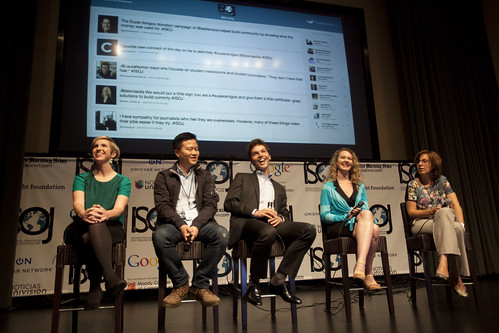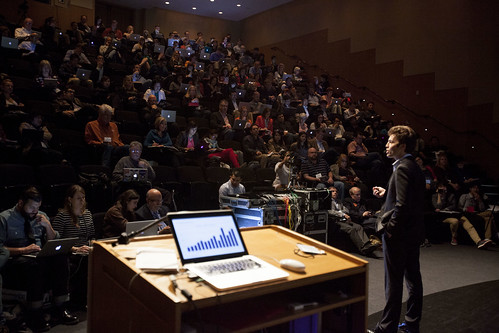April 5, 2014 | Media Startups
ISOJ Panel: Media startups mark change and innovation for future of journalism

The young news ventures represented at the panel “Journalism star startups: building innovative media outlets for the digital age,” on the second day of the 15th International Symposium on Online Journalism (ISOJ), were certainly embracing digital media as the future of journalism. With services ranging from covering violent crimes through arrests and hearings to creating a trustworthy news media for a market where news are consolidated into two opposing sides, these startups showed that with the right tools, digital media should not mean the demise of journalism.
From Laura Amico’s days as an unemployed crime reporter came Homicide Watch, a crime-watching project that started out as a blog and turned into a medium that spans more than one city now, and is being used to train and kickstart journalists interested in crime reporting.
ISOJ 2014: Interview with Laura Amico, from Knight Center on Vimeo.
Homicide Watch was born from what Amico saw as a lack in the conversation about violent crime, something she especially observed in her own D.C. community.
“The news cycle doesn’t suit following crime very well,” she said, adding that there’s too many cases where the people just get swept away and forgotten. In that aspect Homicide Watch excelled, since it raised questions about how the criminal justice was working and how we would like it to work instead.
Taiwan’s The News Lens was also born out of the same idea of wanting to change the way media worked. Chung said the public in Taiwan don’t trust the media, and there’s frustration among young people over the very biased and consolidated media. The News Lens was born out of that disappointment.
“We don’t target anyone over 60,” founder and CEO Joey Chung said. “My parents said they didn’t know what I was doing, I told them I didn’t care.”
Now it’s one of the fastest growing startups in Taiwan and employs over 180 writers. As a medium, they revamp their look every three or four months, and they’re constantly exploring new features, such as 90 second-long newscast, which is roughly the amount of time between subway stops.
The fact that The News Lens was blocked in China about three months after their launch is seen as a success, Chung said. An investor actually called to congratulate them afterwards.
ISOJ 2014: Interview with Joey Chung, from Knight Center on Vimeo.
As far as news media aiming to represent the younger generation, The News Lens is not alone. Jake Horowitz, CEO an co-founder of PolicyMic, created his medium in response to what he referred to as a failure of legacy media to reach Millenials due to missing the platforms and topics the younger generation is looking for.
“This is no longer about online news sites, but about social media,” Horowitz said, adding that a news site is only as good as its distribution channels. “The home page is dead – we are incredibly distrustful of mainstream media institutions.”

Horowitz said PolicyMic aims at deepening their news coverage, to tell stories not only with words and photos, but with data visualization and graphics.
La Silla Vacía was created in order to show the true balance of power and corruption present in Colombian politics, and León placed an emphasis on social media, saying that the World Wide Web has now turned into the World Live Web.The same emphasis on social media is seen on Juanita León’s Bogotá-based startup, La Silla Vacía, that León said will soon begin exploring the option of building a social media network based around journalism.
The site, which León said is now the third online media site most read by opinion leaders, is equipped with a live updates section, and it counts with 327,000 Twitter followers.
“We’ve become a lab for innovative journalism,” León said, adding that they’re aiming to hold a permanent conversation with the audience. “But forget about the big shot journalists, we’re bringing in really smart people from the universities.” This was in response to the difficulty the had in convincing good, experienced journalists to come work for them, because they tend to be traditionalists who don’t take risks.
“How you see yourself as media matters, the key is transparency,” she said.
This emphasis on transparency is something also seen at The Texas Tribune, whose editor Emily Ramshaw outlined their business model, which included corporate sponsorships, major donors, foundations, memberships and events, as well as their approach to journalism during the presentation, which included traditional beat reporting on Texas politics and data and app management teams.
“We believe our readers and users should be in the same room with the people who represent them, “ Ramshaw said of their journalistic approach.
However successful they may be, The Tribune is still a non-profit, with free access for regional papers to Tribune stories and content, which is why you can find Tribune bylines on many regional newspapers across Texas.
While many are signaling the entrance of the digital age as a doomsday for traditional journalism, these startup companies are finding ways to use the digital age to their advantage, which may be changing the way media companies go about aggregating and publishing their news content, but it’s ensuring journalism’s survival.
And even thought the media industry is changing, this change could be for the better, as Homicide Watch’s Amico pointed out when she said that newsrooms who say yes to Homicide Watch are saying yes to changing the way the news media covers homicide and violent crimes.
The Millennial generation has not been served well by the mainstream media — not just because of a continuous focus on labeling Millenials as lazy and unfocused – and this is a fast-failing model.
“Startups have a huge opportunity to experiment,” said PolicyMic’s Horowitz. “Focus groups are important, but you have to test content too.”

